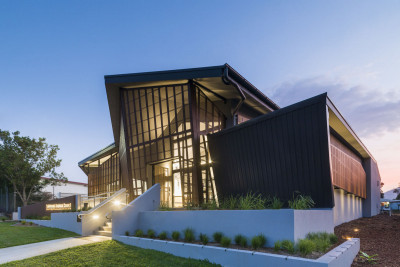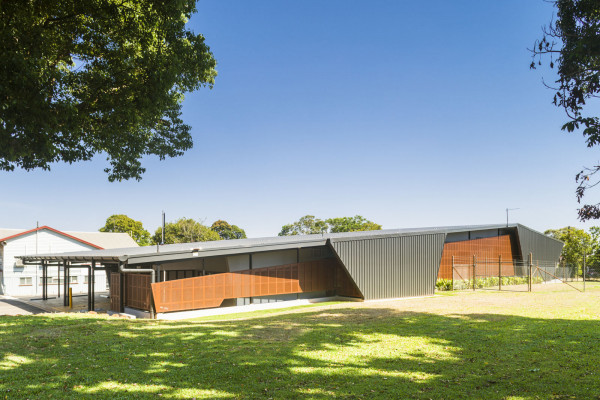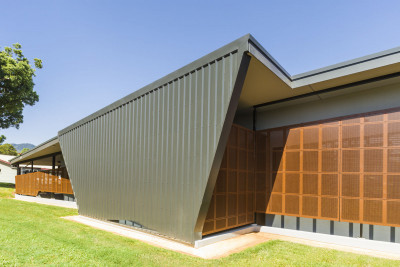
Award-winning community education and disaster centre uses Stramit for structure
3 December 2020
 The Atherton Community Education and Disaster Coordination Centre (Coordination Centre), which is supported by Stramit Monoclad® roof and wall products, has been named Regional Project of the Year by the Australian Institute of Architects at the Far North Queensland Regional Architecture Awards 2020, where it also received a commendation for commercial architecture.
The Atherton Community Education and Disaster Coordination Centre (Coordination Centre), which is supported by Stramit Monoclad® roof and wall products, has been named Regional Project of the Year by the Australian Institute of Architects at the Far North Queensland Regional Architecture Awards 2020, where it also received a commendation for commercial architecture.
The Coordination Centre, which was designed by Coburn Architecture and constructed by Hutchinson builders, officially opened in July 2019. It is a multi-functional facility where community members, groups and government agencies can conduct regular training and education sessions, primarily focused on disaster resilience and preparation. It is also a regional facility for disaster management, response and recovery, used as the local disaster coordination centre, and the home of the local State Emergency Service (SES).
The building has been designed to withstand category 5 cyclones, with metal screening enveloping the main building structure to protect openings and patios, securing the facility.
Stramit’s Monoclad® product was used for the Coordination Centre roof and wall cladding in conjunction with the MonoLap® roof lap joint system, which provides a strong joint and low-profile, weather-resistant seal between overlapping cladding sheets. MonoLap® uses materials that are suitable for extreme weather environments, providing peace of mind and confidence in the system.
 Ken King, technical services consultant, Stramit Qld/NT, said, “Stramit’s Monoclad® cladding was perfect for the Coordination Centre roof and wall application due to its visual appeal, strength, wide cover, light weight and weather resistance. The Monoclad® water-carrying capacity and weather resilience suit building requirements for extreme weather conditions in the Atherton region.
Ken King, technical services consultant, Stramit Qld/NT, said, “Stramit’s Monoclad® cladding was perfect for the Coordination Centre roof and wall application due to its visual appeal, strength, wide cover, light weight and weather resistance. The Monoclad® water-carrying capacity and weather resilience suit building requirements for extreme weather conditions in the Atherton region.
“By pairing the MonoLap® and Monoclad® solutions for this significant community project, Stramit was able to deliver a more robust Coordination Centre building. This also saved construction time and costs by eliminating the need for on-site roll forming, step jointing or additional purlins for the long-run roof structure. Stramit’s service promise meant that the high-quality products were delivered on site exactly when they were needed, ensuring the project remained on target.”
Tablelands Regional Council Mayor, Rod Marti, said, “The Coordination Centre is an important asset for the community because it helps make the Tablelands region even more resilient and better equipped to prepare for, respond to, and recover from disasters.
“This is an essential facility that provides local disaster management agencies with the necessary tools for response and recovery efforts, allowing them to act with coordinated efficiency before, during, and after a disaster.”
The state-of-the-art facility also provides opportunities for the community to come together, building on already strong relationships between Tablelands Regional Council and community groups, local organisations, state and federal government agencies and the Local Disaster Management Group through education and training.
Rod Marti said, “The Coordination Centre has hot desks and conference rooms for hire for community education, training, meetings and disaster management. It is also a hub for training and education in areas such as first aid, disaster preparation and recovery, and business continuity.”
Alanna Coburn, director, Coburn Architecture, said, “Coburn Architecture is extremely proud of the Coordination Centre project, and of the award that the building has received. The team at Stramit were great to work with, helping to select the best products and systems to meet the technical and aesthetic design requirements for the project, which ensured we achieved a high-quality built outcome.”
The Atherton Community Education and Disaster Coordination Centre is a joint initiative between the Queensland Government and Tablelands Regional Council. It was funded with $2.8 million from the State Government’s Local Government Grants and Subsidies program, and $2.25 million from Tablelands Regional Council.
More stories you may be interested in
19 October 2020
Stramit 2020 Product and Service Guide out now
The latest edition of the Stramit Product and Service Guide is out now!
30 June 2025
Introducing Stramit's new, groundbreaking innovation: the RES-EASE® Residential Roofing System Solution
Creating quieter spaces, increased comfort and faster installation.
Stramit is proud to unveil a groundbreaking innovation set to …